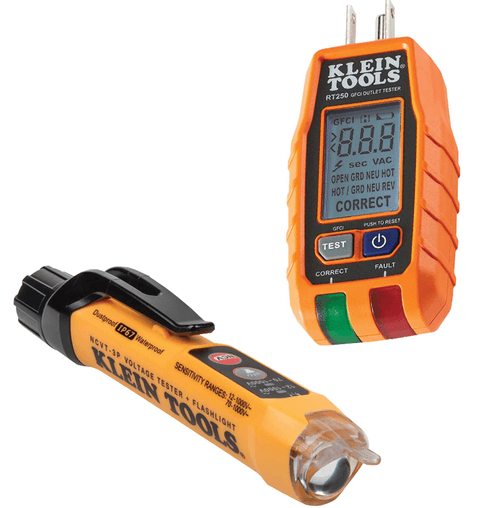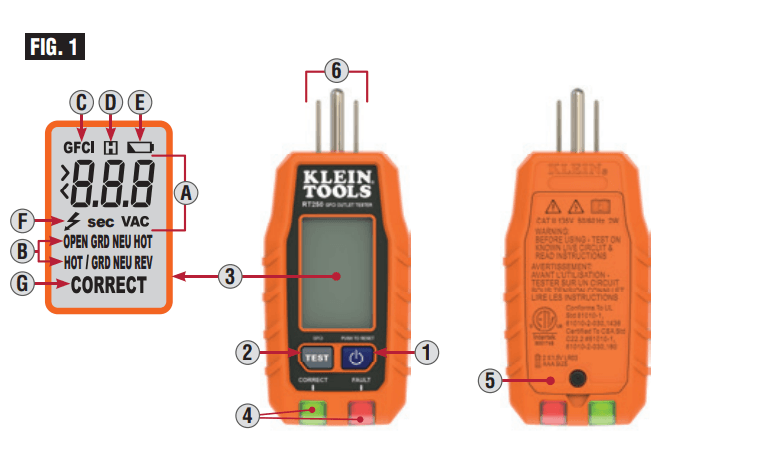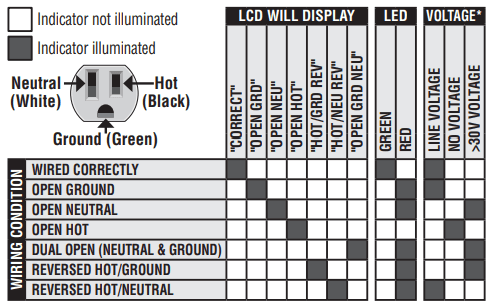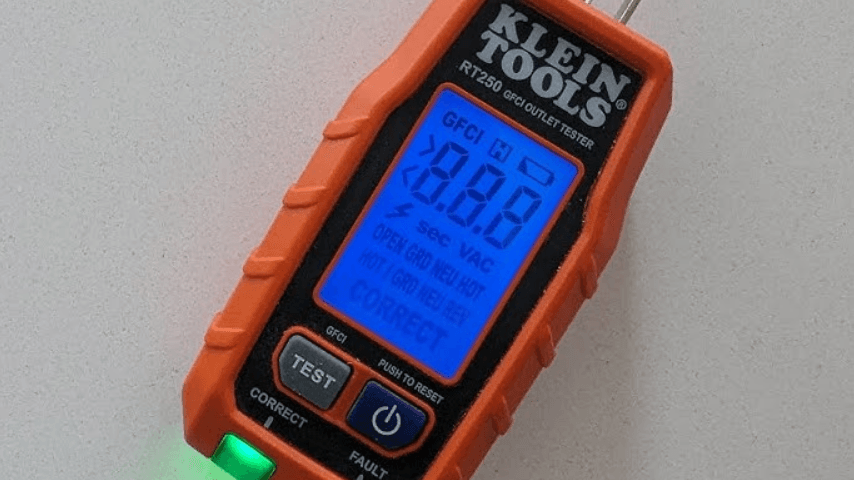
Klein Tools RT250 GFCI Electrical Outlet Voltage Tester


TESTER
- Power button
- GFCI Test Button
- LCD Display
- Indicator LEDs
- Battery Compartment
- Plug
LCD
- A. Voltage / GFCI Trip Time (in seconds)
- B. Wiring Fault Indicators
- C. GFCI Mode Indicator
- D. Hold Mode Indicator
- E. Low Battery Indicator
- F. Hazardous Voltage Indicator
- G. Correct Wiring Indicator
NOTE: There are no user-serviceable parts inside the tester.
- LCD readout of voltage and wiring faults
- Inspect and check GFCI devices, including the time to trip breaker
- Detect & identify common wiring faults and test wiring condition at electrical outlets
Durability
- Drop Protection
- Safety Rating
GENERAL SPECIFICATIONS
The RT250 is an electrical circuit tester that tests the wiring conditions at an electrical outlet and inspects GFCI devices. The LCD displays the voltage, the wiring fault, and the GFCI trip time. It is designed for use with North American 120V electrical outlets.
- Operating Altitude: 6562 ft. (2000m)
- Relative Humidity: <85% non-condensing
- Operating Temp: 32° to 122°F (0° to 50°C)
- Storage Temp: -4° to 140°F (-20° to 60°C)
- Dimensions: 4.5″ x 2.0″ x 1.3″ (114 x 50 x 33 mm)
- Weight: 4.8 oz. (136 g) including batteries
- Battery Type: 2 x 1.5V AAA Alkaline
- Standards: Conforms to UL STD.61010-1,
CAT II: Measurement Category II is applicable to test and measuring circuits connected directly to utilization points (socket outlets and similar points) of the low-voltage MAINS installation.
Specifications subject to change.
WARNINGS
To ensure safe operation and service of the tester, follow these instructions. Failure to observe these warnings can result in severe injury or death.
- RT250 is designed for use with North American 120V electrical outlets. DO NOT connect to higher voltage electrical supplies.
- Prior to use, always verify the tester’s operation by testing on a known live and correctly wired electrical circuit.
- DO NOT use if the tester appears damaged in any way.
- The tester is intended for indoor use only.
- Other equipment or devices attached to the circuit being tested could interfere with the tester. Clear the circuit before testing.
- This tester only detects common wiring problems. Always consult a qualified electrician to resolve wiring problems.
- DO NOT attempt GFCI ground fault testing on an incorrectly wired circuit. Consult a qualified electrician to resolve wiring problems.
- For use on 3-wire outlets only.
OPERATING INSTRUCTIONS
RT250 is designed for use with North American 120V electrical outlets. DO NOT connect to higher voltage electrical supplies.
POWER ON/OFF
Press and hold the power button 1 for two seconds to power ON/OFF the tester. When the tester is powered ON and not connected to a circuit, the LCD 3 will display ” 000″ A and “Open Hot” B condition.
NOTE: The tester will automatically power OFF after 3 minutes of inactivity to conserve battery life.
WIRING CONDITION
Prior to use, always verify the tester’s operation by testing on a known live and correctly wired electrical outlet. With the tester powered ON and inserted in the outlet, the Hazardous Voltage Indicator F will appear, and the red or green Indicator LED(s) 4 will illuminate. If the red indicator LED illuminates, unplug the tester to read voltage A and wiring fault B. The tester holds the information on the LCD, and the Hold Mode indicator D will illuminate. During this time, the LCD will blink. The LCD will reset once it is plugged into another circuit, or, if no voltage is detected, the LCD will blink during the
time-out period prior to auto-power off. If the tester indicates that the circuit is not wired correctly, consult a qualified electrician.
NOTE: Conditions NOT indicated include, but are not limited to, quality of ground, multiple hot wires, reversal of neutral and ground conductors, and combinations of defects other than dual open neutral and ground.
NOTE: All appliances or equipment on the circuit being tested should be unplugged to help reduce the possibility of erroneous readings.
*Expected voltage reading on LCD based on the indicated wiring condition.
NOTE: If the detected voltage is either low (30–85V AC) or high (135–150V AC), the red LED will illuminate. It is possible to have the red LED (indicating low or high voltage) and the green LED (indicating correct wiring) illuminated simultaneously.
GFCI GROUND FAULT TESTING
NOTE: Prior to using this tester, check the GFCI device’s user manual for information on how the specific device operates.
Power ON the tester 1 and insert the plug into the outlet of the circuit under test. On a properly wired circuit, the green Indicator LED 4, the Hazardous Voltage Indicator F, and the Correct Wiring Indicator G will illuminate. If the tester indicates that the circuit is not wired correctly, DO NOT attempt to initiate an electrical testing event. Consult a qualified electrician. To initiate an electrical fault, press the GFCI button. The tester will create a 6mA to 9mA ground fault to trip the GFCI device. If successful, the display will toggle A between the pre-test voltage and the time to trip the breaker. If the circuit remains
energized, or if “>6 sec” appears on the LCD, the device being tested may be miswired, may not be installed correctly, or may not be functioning correctly. Consult a qualified electrician.
BATTERY REPLACEMENT
When the Low Battery Indicator E illuminates, replace the batteries.
- Loosen screw from battery cover 5.
- Replace 2 x AAA batteries (note proper polarity).
- Replace battery door and fasten securely with screw.
To avoid the risk of electric shock, unplug from any voltage source before removing the battery door. To avoid the risk of electric shock, do not operate the tester while the battery door is removed.
CLEANING
Be sure the tester is turned off and wipe with a clean, dry lint-free cloth. Do not use abrasive cleaners or solvents.
STORAGE
Remove the batteries when the tester is not in use for a prolonged period. Do not expose to high temperatures or humidity. After a period of storage in extreme conditions, exceeding the limits mentioned in the General Specifications section allows the tester to return to normal operating conditions before using.
WARRANTY
DISPOSAL / RECYCLE
Do not place equipment and its accessories in the trash. Items must be properly disposed of in accordance with local regulations. Please see www.epa.gov or www.erecycle.org for additional information.
For more manuals by Klein Tools, visit ManualsLibraryy
Klein Tools RT250 GFCI Electrical Outlet Voltage Tester-FAQs
How does a GFCI outlet tester work?
A GFCI tester checks for differences in electrical current between the hot and neutral wires. If there’s a mismatch, it suggests that electricity may be leaking, and the GFCI quickly cuts off power to prevent shock or injury.
Are outlet testers completely accurate?
Outlet testers can indicate basic wiring problems, but they aren’t 100% reliable. For safety, never assume an outlet is safe just because the tester doesn’t show a fault—some live circuits may still appear inactive.
What is the purpose of a GFCI device?
A GFCI (Ground Fault Circuit Interrupter) protects you from electrical shock by quickly shutting off power when it detects a ground fault. It’s a safety device that reduces the risk of electrocution.
How does a GFCI outlet function?
A GFCI compares the current going to a device and returning from it. If there’s a difference as small as 4–5 milliamps, it shuts off the power within a fraction of a second to prevent harm.
Can I use a GFCI tester on a standard outlet?
Yes, but it won’t trip the outlet like it would with a GFCI outlet. It can still tell you whether the regular outlet is receiving power or if there are wiring issues.
What is the Klein RT250 outlet tester used for?
The Klein RT250 tests both standard and GFCI outlets for common wiring problems like open ground, reverse polarity, or open hot. It has indicator lights and a guide chart for quick diagnosis.
Why is a GFCI important in your home?
GFCIs protect against electrical shocks, prevent fires caused by ground faults, and enhance overall electrical safety, especially in wet or damp locations.
How quickly does a GFCI respond to danger?
A GFCI trips in as little as 1/30th of a second when it detects even a tiny imbalance (about 5 milliamps) in the electrical flow.
Where should GFCI outlets be installed?
GFCI outlets are typically used in bathrooms, kitchens, garages, laundry rooms, and outdoor areas—anywhere water and electricity might come into contact.

